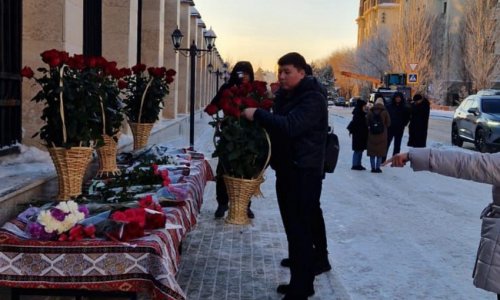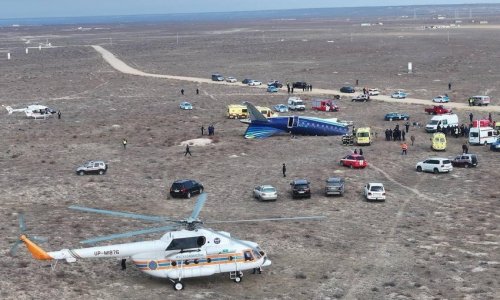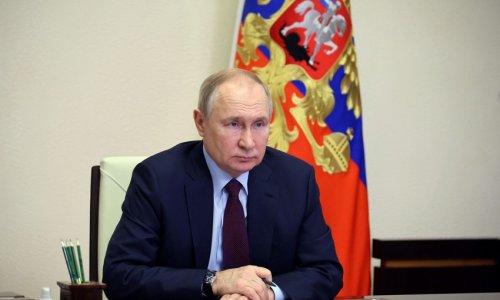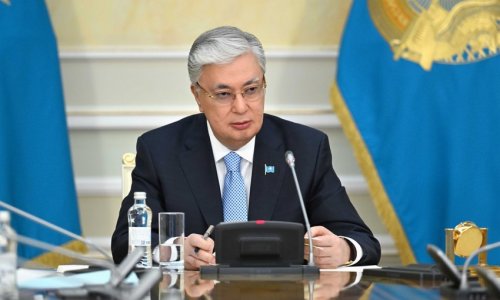Follow us !
Is Russia ready to move into eastern Ukraine?
World
23:30 | 10.04.2014

Is Russia ready to move into eastern Ukraine?
With Nato assessments that there are some 40,000 Russian troops massed on the Ukrainian border ready to move at a few hours' notice, the heightening war of words between Moscow and Kiev raises a genuine prospect of conflict.If Russia requires a pretext to move into eastern Ukraine, then many of the elements of that narrative are already in place.But what of the Russian military's capabilities? What can be deduced from what we have seen so far of Russian operations in Crimea?This 14 March 2014 photo of the Primorsko-Akhtarsk airbase in south-western Russia shows a build-up in the number of tactical aircraftThere are primarily Sukhoi Su-25 Frogfoot strike aircraft (lower left) and Sukhoi Su-27 (on the right)While possibly deployed to initially be available over Crimea, they are also within range of a lot of eastern Ukraine and represent a threat to any Ukrainian armoured unitsKeir Giles, director of the Conflict Studies Research Centre (CSRC), a group specialising in Russian military affairs, notes that "this is a very different Russian army from that seen during the Georgia war of 2008".Despite the apparent easy victory in Georgia, serious deficiencies in Russia's military performance were obvious.This "was a post-Soviet army, not much changed from the 1980s, and designed for a very different form of combat", he says."Serious lessons were learnt in terms of organisation, command and control, equipment, and especially inter-service co-operation."Communications between ground and air units were a major problem, due to a lack of effective forward air controllers properly embedded with ground units, and several of the Russian air losses were apparently shot down by their own side."Plans for modernisation were under way before 2008. But the Georgia conflict confirmed the need for change and gave the necessary political impetus for fundamental military reform.Roger McDermott, senior fellow in Eurasian military studies at the Jamestown Foundation in Washington DC, however, stresses the limits of the Russian reform programme."The failures of the campaign in Georgia were used as an excuse to launch a pre-planned reform and modernisation of the conventional armed forces. But the reform largely failed due to poor planning and internal corruption," he says.Nonetheless, he notes that "efforts to change the structure of the military and modernise equipment continue".Russia's ground forces "are largely unreformed in the sense that they moved to eliminate 'paper units' (many of which barely existed in practice) in 2008-09 and claimed to create a permanent readiness force based on brigades", according to Mr McDermott."In reality, this was ruined by too many 12-month conscripts and not enough contract personnel, while they also failed to develop a proper well-trained, non-commissioned officer cadre."This sequence of images shows Russian troop formations deployed to a training centre west of Belgorod in western RussiaImagery of the bivouac area at the Belgorod training centre indicates a significant presence of military vehicles consistent with those found in an airborne divisionFurthermore, a significant number of tents are present to house personnelAdditional satellite imagery captured on 31 March 2014 indicates an increased troop presence at Belgorod, including activity around the training centre's airfieldAlso visible are multiple temporary helipads and possible fuel tankers'Superior'While stressing the limits of Russia's military reforms, it is clear that some significant improvements have been undertaken.Some of these were visible in the units employed during the takeover of Crimea."In the last couple of years, there have been indications, even in military parades in Moscow, that this is a more Western-looking army," Mr Giles says."New load-carrying equipment for ordinary soldiers and a wider distribution of personal radios - until recently the preserve of platoon commanders at best - are simple and obvious indications of how the Russian army has invested in improving and modernising its equipment overall."The CSRC says it has tracked many of the units involved in the Crimea operation."They were drawn from a wide range of Russia's rapid reaction forces, not just the airborne units that are traditionally thought of in this role," says Mr Giles."There were elements from the special forces reconnaissance brigades and the marine infantry."Whatever its shortcomings, Mr Giles says "today the Russian military is vastly more capable than it was in 2008 and much more capable than certainly the Ukrainians - and superior to the forces currently deployed on the territory of all of its Western neighbours".He believes that Russia can sustain this military threat to Ukraine for some considerable time."The Russian units deployed on Ukraine's eastern border can probably remain in the field longer than many Western planners assume," he says."Russia is not much concerned at inconvenience or short-term financial costs if it makes long-term strategic gains."Many indicators and warnings of preparation for a possible invasion are in place, including logistics, food supplies, medical services, and interior troops which would be used for control of occupied areas," he says."But this is not necessarily an indication that Russia will invade, simply that Russia wishes to be prepared to do so given the opportunity or the perceived necessity. "And he argues Moscow has gone to considerable lengths to be in a position to act."Prior to the crisis coming to a head, every major amphibious assault ship Russia had in Europe was pre-positioned in the Black Sea, with units moved thousands of miles from both the Baltic and the Northern Fleets."Short warWhile Russia may be able to keep its forces in the field for some weeks or even months, Mr McDermott notes that if Russia does make its move, any conflict will have to be over swiftly."Any intervention in Ukraine must be resolved within days, Russia has no defence or economic capacity to go in for the long haul," he says.Ukraine is of huge strategic importance to Moscow; Mr McDermott underlines the importance of seeing this through Russia's eyes."This crisis seen from Moscow's perspective, is a 'Eurasian crisis', not a European crisis as such," he says."That means it is about Russia and its future role in Eurasia."Russian President Vladimir Putin "learnt to play hard ball in this crisis by carefully observing how the US and Nato acted since 1999", Mr McDermott says."He saw Nato out-of-area operations as a threat to Russian interests, an alliance that expanded beyond its means, and a US that acted as a global hegemon, including promoting 'colour revolutions' close to Russia."The latest crisis was one step too far, and Putin relied on a Russian intelligence assessment that views the events of the Maidan [the popular protests in Kiev and other cities] in a very different way to the West's reading - and he made his move."(BBC)ANN.Az










